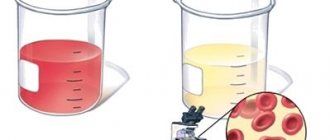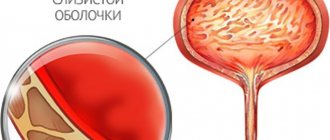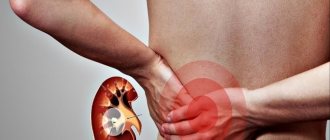Urologist
Belkin
Andrey Ivanovich
19 years of experience
Urologist of the first category, member of the European Association of Urology
Make an appointment
The inflammatory process in the kidneys can be sluggish and practically not manifest itself, but more often the pathology is indicated by a whole set of characteristic symptoms. The disease was called “nephritis”, various types of which have now been studied in detail and described in the medical literature. Inflammation may affect the tissue of one or both kidneys, which is determined during the diagnostic process. Practical experience in the treatment of nephritis allows us to count on stable and long-lasting results. Especially if the patient seeks medical help in a timely manner and strictly follows the specialist’s instructions.
Types of jades
Depending on the location of the inflammatory process, there are:
- Glomerulonephritis is inflammation in the area of the kidney glomeruli. The disease is autoimmune in nature.
- Pyelonephritis, or kidney nephritis, is a lesion of the kidney tissue and pelvis.
- Hereditary nephritis is a disease whose first symptoms appear in childhood.
- Interstitial nephritis is inflammation in the area of the renal tubules, as a result of which the conductive function of the kidneys is impaired.
- Radiation nephritis is an inflammatory process due to irradiation of the body or undergoing a course of radiation treatment.
A comprehensive diagnosis of the patient’s body allows one to accurately identify the site of inflammation and take measures to slow its spread and gradual extinction.
Symptoms of the disease
Symptoms are usually the same, regardless of the cause of kidney damage, and are also similar for children of any age - from newborns to teenagers:
- swelling;
- decreased appetite;
- general weakness;
- feeling of dry mouth;
- chills;
- skin redness;
- dry skin, hair, nails;
- headache;
- pain in the lumbar area;
- convulsions;
- small volume of daily urine;
- bloating;
- vomiting and other gastrointestinal disorders.
If the disease lasts for a long time, then the death of a large number of renal glomeruli occurs. As a result, kidney failure occurs.
The chronic form of the disease is characterized by:
- intense sweating, increasing at night;
- decreased appetite;
- yellow skin tone;
- frequent urge to urinate;
- pain during urination;
- cloudy urine.
Causes
The main cause of the disease is the penetration of infection into the tissues of the kidneys and urinary tract from the outside or from another organ where an inflammatory process is observed at one stage or another. The infectious process can be started by:
- Recently suffered infectious diseases, the pathogens of which were not completely destroyed.
- Regular hypothermia of the body.
- Malfunctions of the immune system, its depressed state due to surgery or serious illness.
- Disruption of the blood supply to the kidneys.
- Stagnation of urine, the chemical environment of which is favorable for the development of pathogenic microorganisms.
Depending on the duration and nature of the disease, acute and chronic nephritis are distinguished. The first type of disease often occurs as a result of taking “aggressive” medications: antibiotics, anti-inflammatory drugs, immunosuppressants and diuretics, analgesics and drugs that suppress pathogens of viral and bacterial diseases. A negative reaction of the kidneys to the drug taken becomes the main cause of inflammation, especially in elderly patients and people with congestion in the body.
Chronic nephritis occurs due to a long course of the acute stage of the disease and the lack of proper treatment. The situation is worsened by uncontrolled use of medications and the presence of foci of cancer in the body. If it is not possible to accurately determine the cause of kidney inflammation, the patient is diagnosed with “idiopathic nephritis”, and the course of treatment is developed on a strictly individual basis.
The main causes of illness in childhood:
- various maternal illnesses during pregnancy;
- diabetes;
- oncology;
- autoimmune processes;
- myeloma;
- vasculitis;
- acute infections;
- thrombosis;
- damage to the body by salts of heavy metals;
- self-medication with medications without specialist supervision (the use of antibiotics without appropriate prescription is especially dangerous);
- reactions to vaccines;
- hypothermia;
- tuberculosis.
Diagnostics
The similarity of the symptoms of nephritis with the signs of influenza and ARVI forces specialists to resort to methods of differentiated diagnosis. The following methods for diagnosing nephritis can confirm doctors’ assumptions about inflammation in the kidney area:
- general and biochemical blood test;
- bacteriological urine culture;
- general urine analysis, study according to Zimnitsky and Nechiporenko;
- Ultrasound of the kidneys with the effect of contrast illumination (Doppler);
- ECG, blood pressure monitoring;
- immunological studies;
- radioisotope method for diagnosing inflammatory diseases.
In rare cases, if test results are in doubt, a decision is made to perform a kidney tissue biopsy. Often, third-party specialists from other fields of medicine are involved in the examination: ENT doctor, gynecologist, dentist, infectious disease specialist, etc. Their participation in the examination allows us to accurately identify the cause of the disease and identify the source of infection hidden inside the body.
Terminology
The concept of “tubulointerstitial nephropathies” in the broad sense of the word includes inflammatory, metabolic or toxic diseases of the kidneys, which occur in contrast to glomerular (glomerular) diseases with primary and predominant damage to the tubules and interstitial tissue of the kidneys. In a narrower sense, the term “tubulointerstitial nephropathies” is more often used to refer to metabolic and toxic lesions without a clear inflammatory component, applying the term “tubulointerstitial nephritis” or, equivalently, “interstitial nephritis” to inflammatory, immunoinflammatory lesions of the tubules and interstitium. In addition to tubulointerstitial nephropathies as independent nosological forms, a tubulointerstitial component can be isolated in a number of glomerular kidney lesions, including chronic glomerulonephritis.
The term “interstitial nephritis” (IN) has existed since the mid-nineteenth century, but over the course of a century and a half it included various concepts. The term “chronic interstitial nephritis” for a long time corresponded to the modern understanding of kidney damage in hypertension - nephroangiosclerosis, primary wrinkled kidney, i.e. designated those types of kidney pathology, which are based on vascular damage; this group then began to include secondarily wrinkled kidney, chronic nephritis of the hypertensive type. IN was contrasted with tubular, parenchymal nephritis with edematous syndrome (corresponding to modern nephritis with nephrotic syndrome). In parallel, in the first half of the twentieth century, the term “tubulointerstitial nephritis” existed to refer to acute renal failure (ARF).
IN, corresponding to the modern interpretation of this concept, was first described in 1898 by Councilman in patients who had diphtheria and scarlet fever. However, for a very long time, IN was identified exclusively with pyelonephritis and was the prerogative of study by urologists. And at present, IN remains poorly known to a wide range of doctors, which is due, firstly, to the relative rarity of the disease, and secondly, to the nonspecificity of most symptoms. Poor knowledge of this pathology by doctors is evidenced by the fact that among the 22 patients with acute IN we observed, 20 were admitted with other diagnoses: 12 with a diagnosis of chronic glomerulonephritis, 3 with acute glomerulonephritis, 2 with pyelonephritis, 3 with systemic lupus erythematosus. At the same time, IN is in most cases a disease with an established etiology, promising in terms of treatment and prevention.
The current wave of interest in tubulointerstitial lesions is associated both with the possibilities of treatment and prevention (obviously greater than with glomerular diseases), and with the increasing frequency of iatrogenic pathology in general, as well as with the assumption of the leading role of the interstitium and tubules in the progression of kidney diseases.
Treatment
A patient with signs of nephritis is given strict bed rest, which helps reduce the rate of spread of infection through the circulatory system and internal organs. You can cope with the disease by:
- Taking medications to eliminate the causes of inflammation. A course of antibiotics, antiviral drugs, hemosorption procedures and plasmaphoresis to destroy the pathogen in the patient’s blood gives a good effect.
- Blocking the development of the inflammatory process and its spread throughout the body. The effect is achieved by taking hormonal drugs, antihistamines, and medications to activate blood circulation in the kidney tissues.
- Symptomatic treatment to alleviate the patient's condition. The course includes water-electrolyte drips, monitoring of daily urination, intestinal or hemodialysis, which allows you to remove metabolic products from the body.
A prerequisite for successful treatment is a diet for nephritis, the main requirements of which are reducing the amount of salt in the diet and limiting the volume of fluid to 700-800 ml, depending on the patient’s body weight. Treatment is carried out under the strict supervision of a doctor, and its content is adjusted as monitoring indicators change and signs of recovery appear.
Publications in the media
Chronic interstitial nephritis (CIN) is a chronic lesion of the tubulointerstitial tissue of the kidneys, caused by the influence of infectious, metabolic, immune, toxic factors, the clinical picture of which is dominated by impaired tubular functions.
Classification • By pathogenesis •• Primary CIN - primarily occurring in the kidney •• Secondary CIN - nephritis is one of the manifestations of a general or systemic disease • By etiology (see below Etiology).
Statistical data. Accurate data are not available due to underdiagnosis. Etiology • Drugs (see Acute interstitial nephritis) • Metabolic disorders: hyperuricemia, hypercalcemia • Immune disorders: SLE, Sjogren's syndrome, chronic active hepatitis, thyroiditis, kidney transplant rejection • Heavy metals: gold, lead, mercury, lithium, etc. • Infections, for example chronic pyelonephritis • Malignant neoplasms: myeloma, light chain disease • Amyloidosis • Kidney dysplasia: polycystic disease, Allport syndrome, etc. • Urinary tract obstruction.
Pathogenesis . Of particular importance in the development of tubulointerstitial inflammation is the predominance of the mechanisms of toxic and metabolic kidney damage over the immune one.
Pathomorphology • Lymphohistiocytic infiltration of the interstitium • Stromal sclerosis • Dystrophy or atrophy of the tubular epithelium • With analgesic nephropathy, the following changes: •• sclerosis of the capillaries of the mucous membrane of the urinary tract •• papillary necrosis •• focal segmental glomerulosclerosis.
Clinical picture • Tubular disorder syndrome • Proximal tubular disorders (complete Fanconi syndrome or partial disorders - proximal tubular acidosis, glycosuria, proteinuria) • Distal tubular disorders (distal acidosis, hyper- or hypokalemia, hyper- or hyponatremia) • Partial tubular dysfunction - depend on the etiological factor • Arterial hypertension (rarely in the early stages, in the later stages and with chronic renal failure - often) • In secondary CIN - symptoms of the underlying disease
Laboratory data • In the blood - anemia, acidosis, increased ESR (more often with immune or infectious genesis) • In the urine - increased volume (polyuria), hyposthenuria, water-electrolyte disturbances, alkaline urine reaction, tubular proteinuria, glycosuria, erythrocyturia, leukocyturia • Hyperuricemia (with gouty nephropathy).
Instrumental data • For all CIN, ultrasound shows a decrease in the size of the kidneys and an increase in the echogenicity (density) of the kidneys • For analgesic nephropathy: •• excretory urography - signs of papillary necrosis (see Renal papillary necrosis) •• CT - calcification of the border of the renal papillae •• cystoscopy - pigmentation of the triangle of the bladder.
CLINICAL AND LABORATORY FEATURES OF SOME CHINA Drug nephropathies • Analgesic nephropathy •• Develops when taking metamizole sodium or combinations of analgesics (paracetamol, phenacetin, acetylsalicylic acid) more than 3 g/day •• More often observed in women over 45 years of age •• Episodes of renal colic in combination with aseptic leukocyturia, gross hematuria •• Microhematuria, moderate proteinuria (massive proteinuria more than 3 g/day - with the development of focal segmental glomerulosclerosis •• Polyuria, hyposthenuria, thirst (100%) •• Renal tubular acidosis (10–25%) •• Reduction in kidney size •• Severe anemia that does not correlate with the degree of chronic renal failure •• Hyperuricemia •• Arterial hypertension is noted in half of the patients •• Acute renal failure (obstruction of the rejected papilla, arterial hypertension, dehydration) •• High risk of developing malignant tumors of the urinary tract •• Analgesic syndrome - combined with kidney damage to other organs: gastrointestinal tract (stomach ulcer, stomatitis), hematopoietic organs (anemia, splenomegaly), cardiovascular system (arterial hypertension, atherosclerosis), neuropsychic sphere (headache, psychosis, personality disorders), reproductive system (infertility , toxicosis of pregnancy), skin (pale yellow pigmentation of the skin).
• Cyclosporine nephropathy •• Develops in a transplanted kidney when using high doses of cyclosporine - 10-15 mg/kg/day •• Interstitial fibrosis •• Arterial hypertension •• Slowly progressive chronic renal failure •• Obliterating angiosclerosis •• Focal segmental glomerulosclerosis with high proteinuria, uncontrolled arterial hypertension and rapidly progressing chronic renal failure.
• Nephropathy caused by taking NSAIDs •• Increased blood pressure •• Edema - primary renal sodium retention due to Pg inhibition •• Acute tubular necrosis with acute renal failure. Toxic nephropathies
• “ Golden” nephropathy (in the treatment of rheumatoid arthritis) •• Glomerulonephritis - membranous, with minimal changes or proliferative •• Tubular dysfunction •• Vasculitis of the renal vessels •• Full restoration of function 11 months after discontinuation of gold treatment.
• Lithium nephropathy •• ADH-unresponsive nephrogenic diabetes insipidus, incomplete distal tubular acidosis and azotemia (rare) •• Nephrotic syndrome. • Cadmium nephropathy •• Impaired functions of the proximal tubules •• Progression to chronic renal failure. • Lead nephropathy •• Decreased GFR, renal blood flow, minimal proteinuria, unchanged urinary sediment, hyperuricemia, low urate clearance, sometimes hypertension, hyperkalemia and acidosis. • Nephropathy with copper administration - rarely observed (Wilson's disease), clinically similar to cadmium nephropathy. • Mercury nephropathy •• Membranous and proliferative glomerulonephritis •• Atrophy of the proximal tubules with the development of Fanconi syndrome •• Progression of chronic renal failure.
Metabolic nephropathies • Urate, or gouty, nephropathy - damage to the tubules by uric acid and urates during alcoholism, treatment of tumors with cytostatics, gout, lead intoxication - there are three types •• CIN •• Urate stones •• Acute uric acid nephropathy (obstruction of the renal tubules by urates with frequent development of acute renal failure). Treatment: diet with the exclusion of purines, allopurinol, forced polyuria, alkalinization of urine • Calcium oxalate nephropathy - damage to the tubules by calcium oxalate crystals during ethylene glycol poisoning, the formation of ileojejunal anastomosis, pyridoxine or thiamine deficiency •• Interstitial nephritis •• Calcium oxalate nephrolithiasis •• Syndrome acute uric acid nephropathy (obstruction of the tubules with crystals with the possible development of acute renal failure).
Other nephropathies that develop secondary to the following diseases • Amyloidosis (see Amyloidosis) • Sarcoidosis (see Sarcoidosis) •• Kidney sizes are usually normal, slight proteinuria •• Hypercalcemia and/or hypercalciuria in sarcoidosis can lead to acute renal failure, nephrocalcinosis or nephrolithiasis • SLE and other systemic connective tissue diseases • For hereditary nephropathy - polycystic disease, Allport syndrome • For urinary tract obstruction (prostate adenoma, urolithiasis, etc.) • For urinary tract infection (chronic pyelonephritis).
Treatment • Cancellation or reduction of the dose of drugs, replacement with an alternative drug • In most cases, a diet that alkalinizes the urine • Sufficient volume of fluid to achieve polyuria • For immune CIN - GC • Correction of water-electrolyte disturbances and ACR • Treatment of arterial hypertension • Treatment of anemia • Treatment of acute renal failure .
Prevention • It must be remembered that in the presence of kidney disease (especially gout, myeloma nephropathy, diabetic glomerulosclerosis) or episodes of acute renal failure in the past, as well as in old age, with heart failure, cirrhosis of the liver, alcoholism and drug addiction, the risk of nephrotoxic effects increases •• Compliance diets •• Achieving forced polyuria with the threat of tubular obstruction with oxalates, urates •• Prohibition of taking analgesics (paracetamol is less toxic) and exclusion of nephrotoxic drugs •• Refusal of X-ray contrast studies in the presence of risk factors for CIN • Reducing doses of cyclosporine to 5 mg/kg/day with monitoring its content in the blood • Early detection and treatment of the underlying disease.
Course and prognosis • Spontaneous restoration of functions or improvement of the course of the disease is possible with rapid withdrawal of the toxic factor, drugs (for example, gold preparations) • CRF is irreversible, more often with analgesic nephropathy. Abbreviation: CIN - chronic interstitial nephritis.
ICD-10. N11 Chronic tubulointerstitial nephritis.
Diagnosis and treatment of nephritis in Moscow
The Clinic of JSC "Medicine" invites patients with suspected nephritis to undergo a comprehensive examination and course of treatment. All necessary services can be obtained at the center, which will save the patient from having to sign up for tests and wait a long time for his turn. Each patient is guaranteed confidentiality, attentive and welcoming treatment, the opportunity to undergo examination and receive advice from other specialized specialists, as well as the quality and safety of the proposed treatment procedures. You can make an initial appointment by calling the specified phone number or through the clinic’s website by filling out the appropriate application.
Methods for preventing childhood nephritis
Parents should be aware that self-prescription of preventive medications is unacceptable. Even after an examination, only a doctor should do this.
As part of prevention, it is important to monitor the child’s lifestyle, promptly identify alarming symptoms, and conduct medical examinations in this profile. For children at risk, physical therapy, hardening, moderate physical activity, and adherence to a certain diet are recommended (consult a doctor to determine this).
Pathogenesis and morphology
In tubulointerstitial nephropathies, pathogenesis depends on the duration and nature of the action of the causative factor on the body. With any of the forms, changes in the epithelium of the tubules occur, more or less pronounced:
- foci of necrosis
- atrophy
- epithelial desquamation
All forms are also characterized by infiltrative processes in the interstitium. In some cases, the damaged brush border of the epithelium of the proximal tubule (due to oxalates, uric acid crystals, paraproteins, etc.) acquires antigenic properties. Because of this, immune complex reactions occur and secondary glomerulonephritis develops.
At the end of the development of tubulointerstitial nephropathies, degenerative changes in the tubular epithelium and interstitial sclerosis begin.
Advantages of SM-Clinic
Our medical center employs some of the best specialists in the Northern capital: pediatric nephrologists, urologists, pediatricians.
“SM-Clinic” has modern equipment, thanks to which diseases are diagnosed quickly and accurately. This makes it possible to return children to normal life in a short time. We have no queues, the approach to each child is always individual and delicate. If inpatient observation is required, comfortable rooms are provided.
Sources:
- N.I. Khlebovets. Tubulointerstitial nephritis in children // Journal of Grodno State University, 2014, No. 1, pp. 94-97.
- Lechon FC, Espi MT, Abal RP, Peiro JLE. Acute glomerulonephritis associated with pneumonia: review of three cases. Ped. Nephrol. 2010; 25: 161-164.
- G.A. Makovetskaya, L.I. Mazur, V.N. Barinov, E.A. Barannikova, E.M. Romadanova, P.V. Morinets. Lupus nephritis in children: manifestation, diagnosis, treatment // Russian Bulletin of Perinatology and Pediatrics, 2021, No. 62(4), pp. 185-186.
Lavrishcheva Yulia Vladimirovna Clinic
Author of the article
Lavrishcheva Yulia Vladimirovna
Doctor of the first qualification category
Specialty: nephrologist
Experience: 13 years
The information in this article is provided for reference purposes and does not replace advice from a qualified professional. Don't self-medicate! At the first signs of illness, you should consult a doctor.
Forecast
The prognosis of tubulointerstitial nephropathies is favorable if the effect of the causative factor on the body is stopped in time. The longer the contact, the less likely the changes are reversible. Recovery time varies from person to person. They are longer in patients with severe interstitial cellular infiltrates and oliguria. Hemodialysis may be necessary. In rare cases, patients develop end-stage renal failure, while acute tubulointerstitial nephritis can lead to the development of acute renal failure, and chronic nephritis can lead to chronic renal failure.
Nephropathy induced by Chinese herbs containing aristolochic acid also progresses with discontinuation of their use. It is also worth noting that it is associated with a significant increase in the risk of malignant tumors of the bladder, ureter and urethra.






